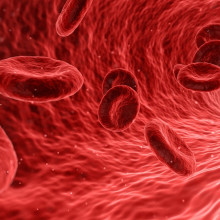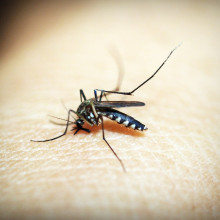AstraZeneca Covid vaccine clots, and self eating plastic
This episode of The Naked Scientists: AstraZeneca acknowledges its Covid vaccine is linked to a rare blood clotting side effect; also, whether scientists are getting closer to cracking nuclear fusion; and how adding bacteria to plastic could be the key to making the stuff break itself down!
In this episode

00:59 - AstraZeneca acknowledges Covid vaccine causes clots
AstraZeneca acknowledges Covid vaccine causes clots
Clare Bryant, University of Cambridge
First this week, the pharmaceutical behemoth AstraZeneca has acknowledged that its widely used Covid-19 vaccine, which is branded as Covishield, can cause rare side effects - including blood clots. Covishield was developed by AstraZeneca in collaboration with the University of Oxford, and has been widely administered across the world. But what is known about the vaccine and its side effects? I went to meet Clare Bryant, an immunologist at the University of Cambridge…
Clare - The AstraZeneca vaccine took a chimpanzee adenovirus, that's the kind of virus that causes colds, but because it comes from a chimpanzee it doesn't actually cause disease in people. What they did was they introduced the spike protein gene, which is the key part of the coronavirus that everybody had the vaccines made against. They introduced that into the chimp adenovirus, and then they used that to vaccinate people. The interesting thing about that viral vector is that it can enter human cells, but it can't proliferate. So disabled virus basically enters human cells, introduces the spike protein gene, then the cells make the spike protein, and this is then passed out of the cell to form a vaccine response. Note at this point please everybody, that that does not mean that the spike protein gene integrates into the human DNA. It just sits there and gets transcribed into the protein. It's a technology that's actually been well worked. The Oxford group who worked with AstraZeneca to make the vaccine have been using this technology for many years, and indeed they used it to make a successful Ebola vaccine.
Chris - Very successful though, wasn't it? The statistic I read was that literally billions of doses were given and millions of lives were saved. So, at the end of the day, it did do a very good job, regardless of side effects which we'll come to in a minute.
Clare - Yeah, for sure. The estimate is it saved 6 million lives. They think it was about 70 to 80% effective, and that's what we needed at the time.
Chris - And what was the outcome that made people concerned about the AstraZeneca vaccine as its rollout occurred?
Clare - What occurred was that very few people had a very serious side effect. It's awful, really awful, for very few people. One in 10,000, I think, they saw this in. They ended up having some kind of clot. So what would happen is that people would produce some clots, blood clots. These could lodge in different parts of the body and then cause very serious outcomes. If it goes into your brain, of course it gives you a stroke. This is life threatening. Certainly life altering and potentially life threatening. This was the problem with the AstraZeneca vaccine. But again, very, very rare. But very, very serious when it occurs.
Chris - Do we know the mechanism of that occurring? Do we know why that one in 10,000 people had this happen to them and the other 9,999 people didn't?
Clare - Not completely, but there is some evidence beginning to emerge to try and understand what's happening. So what happens is, when you get vaccinated, you produce antibodies and you produce predominantly antibodies against the spike protein. But sometimes you can get antibodies produced against other proteins in the body. In this case, what happens in this vaccine induced thrombotic syndrome is that the antibody binds to a platelet protein. Platelets are critical for driving clotting. This then forms a big blob, effectively, and activates the platelets and the platelets then clot. Now exactly why that happens in some people and not others is not really understood. We don't really know clearly yet what parts of the vaccine may be driving this, but it is a well recognised syndrome with some vaccines, very well recognised, and that's part of the mechanism that's happening in this case.
Chris - Do you think it was unique to the Covid use of that vaccine backbone? Because you mentioned they've used it for other things like Ebola and we didn't see this. Is it just the scale of use or is it there's something special about the Covid vaccine and therefore they can carry on using the technology quite safely for other things? Because it is very good, it's very efficient, very agile and very cheap as well, which was one of the attractions. Very good for resource poor settings.
Clare - I suspect it's the scale, to be honest. It's really hard to tell. We don't know the answer to that question, I think. And the scale of rollout of the Covid vaccine was so huge that when you've got a side effect that's occurring in one in 10,000 people, then you will pick it up if you're giving millions, billions of doses. I think we don't know about things like the Ebola vaccine. I think it's possible, but we will have to wait and see unfortunately, unless we actually work out precisely what it is about the AstraZeneca vaccine. Could then the Covid vaccine be modified? Because if we do understand that mechanism and can take that out of the adenovirus backbone, then we would be looking at something that, actually, because the other side effects that occurred were the same as you would get with a cold or flu or something like that, which you also got with the Moderna vaccines. So there's work to be done, I think, on that, and I'm sure that's actively being done because potentially this technology is so fantastic for generating cheap vaccines against serious diseases.

06:22 - How close are we to nuclear fusion?
How close are we to nuclear fusion?
Brian Applebe, Imperial College London
In recent days, there have been interesting developments in the field of nuclear fusion. American researchers claim they have successfully conducted experiments that could make the process easier. Meanwhile, British scientists have unveiled a special type of reactor - which they say offers new ways of controlling the white hot plasmas generated by nuclear fusion. But are we really any closer to solving one of science’s greatest mysteries? Here’s fusion physicist Brian Appelbe, from Imperial College London…
Brian - Fusion is essentially just a way of making nuclear energy, but it's not like the normal nuclear energy we get from power plants which is fission energy which is based on splitting the heavy atom. Instead, nuclear fusion is when we join light atoms together to release energy. It is very attractive because it essentially gives us much more energy per unit mass than we can get from fission or all other energy resources, and it is also a much cleaner form of nuclear energy than fission. However, it is tremendously difficult to do because in order to make fusion energy, we essentially have to make something that is as hot as the centre of the sun in order to induce the nuclear reactions within it.
Chris - Indeed, because of course we know fusion works, we just look up in the sky to see it at work, it's bathing us in glorious sunlight and warmth. But the sun has the advantage that it's about a million times bigger than the earth and millions of degrees in the middle, isn't it? It has some of the problems solved. How are scientists trying to surmount the fact that we don't have a sun to hand?
Brian - Exactly correct. It's really a question of containment or confinement. So with the sun, we make it very, very hot. When you make something very hot, it wants to explode, it's got a lot of energy, it's under high pressure, it will attempt to explode. The sun stays contained because it is so massive there's a huge gravitational force that keeps it confined whereas, on earth, when we want to generate nuclear fusion energy, we must find alternative manmade ways of confining this very hot material in which the nuclear reactions are happening. Scientists have looked at various ways of trying to confine this very hot (what we refer to as) plasma. When we make the nuclear fuel very hot, it becomes a plasma and scientists have found various ways of confining or containing these hot plasmas, for example, as has been in the news recently, using a magnetic field.
Chris - There's an announcement this week about a wonky or twisted donut. They're dubbing it the 'stellarator.' This is the company or the group Type One Energy. They're enthusiastic about this. Why do they think this will be the game changer or a contributor to becoming a game changer?
Brian - There are many reasons for the excitement, some of which are based on science, more of which are based on economics and money. In particular, the accelerator is a design in which you essentially twist the magnetic field lines to make them into a closed configuration in a manner that very effectively contains this hot plasma. The announcement is Type One Energy, this private fusion company, have got a particular design which they think, on paper, should be able to give them a net energy gain, i.e. get more energy out of the system than you're putting into heat and confine the plasma in the first instance. But much of the excitement about this is because of technological developments that we've had over the last few years. The basic accelerator design itself dates back to I think the 1970s, but what's advanced a lot in the intervening years is technologies like superconducting magnets that actually make it efficient to generate these magnetic field configurations.
Chris - They're saying they want to have a plant to test this active in Tennessee by 2025. That's literally next year.
Brian - Which is very ambitious. You know, I guess it is nice to see such ambition. I've been working in this field for over 10 years and in the last maybe five years there's been a lot of excitement, partly because there's lots of money being invested in the field, there's lots of startup companies that are pursuing different designs, planning to do lots of exciting things, and I think it's very difficult to evaluate all of these in isolation. What we look at is the fact that across the whole field we're seeing a lot of advances both on the scientific and on the economic side of things. It's following a pattern where we've got a lot of companies and laboratories who are making a lot of rapid progress.
Chris - And you talk about the advancements in the science right on cue because there is a paper in the journal 'Nature' this week looking at this. What are they doing and saying?
Brian - This is quite interesting because this is very much a scientific development in fusion. This is a different form of twisty magnetic fields. This is the tokamak, which is essentially a donut shape of magnetic field lines. And there is the DIII-D tokamak in San Diego run by General Atomics, that's a well established device that they've been doing experiments on for a very long time. But they've made a breakthrough in which they've found a way that they can actually keep their hot plasma contained using the magnetic fields, but they've increased the density of the plasma which they're containing quite significantly. That's very exciting because essentially the denser the plasma that we're confining, the more nuclear reactions can happen and the more efficient the whole process can be. So by making lots of the subtle changes to their system at DIII-D, they've been able to increase the density above what was previously thought to be the upper limit on densities that could be contained. From a scientific point of view, this is a very exciting development for tokamaks. The big question with this is how it scales up to larger tokamak devices because the DIII-D device is actually very small by the standards of tokamaks. It's only, I think, of order about two metres in diameter whereas the biggest tokamaks that are currently being planned and built are tens of metres in size; an order of magnitude bigger. What's not clear yet is how the results from DIII-D could actually scale to these larger machines.

13:04 - Women make better doctors
Women make better doctors
F. Perry Wilson, Yale School of Medicine
It’s official: women are better doctors than men! That’s at least according to a new study called "Comparison of Hospital Mortality and Readmission Rates by Physician and Patient Sex", which finds a small but significant benefit to women being looked after by female doctors. It’s been published in Annals of Internal Medicine. F. Perry Wilson, from Yale School of Medicine - and author of How Medicine Works and When It Doesn't - has been taking a closer look at it for us….
Perry - This was a study that was trying to figure out if there is a benefit to being treated by a physician who matches your sex or is different from your sex. There have been studies in the past that have suggested that in particular women patients do a bit better when cared for by female physicians. And this was seeking to delve a little bit deeper into that.
Chris - This word 'better'. How do we get underneath that though? Because that can mean a range of different things. Are you cared for better because someone cares for you more? You feel better looked after? Do you get better faster? Do you die less often? What does that word better mean?
Perry - I agree. I think there's a lot of ‘better’ that would be very subjective. You know, it would just be up to how a patient feels after they're interacting with the doctor. But in the case of the study that we're talking about, better was quite literally defined as whether you were more likely to survive for 30 days after you were admitted to the hospital. Although it's probably not capturing everything about quality of care, it's nevertheless an outcome that many of us care very much about.
Chris - So who were the patients? Where did they get the data from?
Perry - These are patients who use the Medicare insurance system in the United States, which is available to everyone above age 65 in this country. And so they were slightly older patients. They were admitted to the hospital for an acute condition. So they were ill. It wasn't a scheduled admission to the hospital. And they were treated by what is known as a hospitalist physician. These are doctors who really just care for patients while they're in the hospital. They're not their GP or primary care providers, we might call them over here. And importantly for this study, patients in the United States don't really get to choose who their hospitalist is. It's just whoever is the next one available when they're admitted to the hospital. And that means that they can't really have a say in whether it is a female or a male hospitalist.
Chris - So there's an element of randomisation to this. Statisticians love this kind of thing because it means that you are taking one step closer to it being unbiased.
Perry - It wasn't truly randomised where a coin was flipped or a computer generated a random number and the patient was assigned based on that. But if you look at it, it does seem that the patients that were treated by male hospitalists and the patients that were treated by female hospitalists, they seem very similar. They're about the same age, about the same level of sickness. And so while not a truly randomised trial, it's better than a lot of the observational research that comes out.
Chris - So go on then, tell us what the outcomes were. When they broke this down by the sex of the patients and the sex of the doctors, what did they find?
Perry - So we're talking about a million patients, across around 50,000 doctors. And what they found, first of all, was that female patients tend to survive a bit better than male patients. The death rate at 30 days was around 8.2% for females, around 10% for male. That's independent of the sex of their physician. And this is not a surprise. We actually know from multiple studies that men do worse after a hospitalisation than women. It may be because they're a bit sicker when they come in, but that's not too much of a surprise. What was more of a surprise was that women who were cared for by female doctors were statistically likely to live longer, to be more likely to survive at 30 days than if they were treated by male doctors. That was not seen among male patients. So the sex of the doctor did not matter for men, but for women there was a small but statistically significant effect on the order of about 0.2% difference in survival at 30 days. But nevertheless, there it was. A suggestion that females being treated by females might lead to better outcomes.
Chris - If you delve into the data, are there any possible differences between the kinds of jobs that women doctors do and male doctors do that might account for that?
Perry - It's such a good question. Obviously, after you look at those results, the very next thing you want to ask is, 'okay, well why <laugh>?' Why did this happen? And one possibility, as you suggest, is that female hospital doctors do kind of different stuff than male hospital doctors. And one thing that did show up in the data is that they tend to see slightly less patients. That might suggest that, well, if you see less patients, maybe you have a little bit more time for each patient that you do see. And time is an important thing that we need when we're caring for patients to make sure that we're listening to them and making our diagnoses correct and not being too frazzled and whatnot. So that's certainly a possibility. There's also, of course, the more difficult things to measure. There have been studies in the past that suggest that female physicians are less likely to dismiss the concerns of female patients compared to male physicians. And so there might be an element here of women kind of understanding women and how they describe pain and how they describe symptoms that men don't understand as well. Very difficult to untangle though.
Chris - You are married to a doctor. I'm married to a doctor. We are both doctors. How do we survive with our egos intact?
Perry - <laugh> As male doctors? I think if you're married to a female doctor, you've probably already internalised the idea that they are better than we are. So I was okay with it.

18:45 - Bacteria infused plastic designed to eat itself
Bacteria infused plastic designed to eat itself
Han Sol Kim, University of California, San Diego
Humans produce around 350 million tonnes of plastic waste every year. And, because of its chemical composition, some of that plastic will still be hanging around in our environment for centuries to come. But a team of scientists in the United States believe they have a solution - which involves "self-digesting plastic" that is impregnated with dormant bacteria that can reawaken when the plastic is dumped and break it down. Here’s Han Sol Kim at the University of California, San Diego…
Han Sol - We wanted to mitigate plastic pollution because plastic pollution is one of the pressing environmental problems. And many plastics are escaping our recycling or collection effort and reaching the environment. So we want to make inherently biodegradable plastics that can naturally break down once they are lead to the environment.
Chris - And so what's your solution? How might we be able to achieve that goal?
Han Sol - Inspiration for this study came from the idea of pairing plastics with bacteria because bacteria can program various functions into plastics such as biodegradability.
Chris - Say that again. So you've got bacteria that can change the way plastic behaves.
Han Sol - Yes. Because some bacteria are known to break down plastics. So we envision that if we can incorporate bacteria into plastic, the bacteria will break down the plastic at the end of its lifecycle.
Chris - Will this work for any plastic or are there specific types of plastic? Because plastics come in different formulations and types, don't they?
Han Sol - That's a really good question. But for this work, we only focused on a specific plastic, which is called thermoplastic polyurethane. We screened and engineered bacteria specifically for this plastic. But I believe that if we can screen and engineer bacteria to other plastics, we will be able to expand our work to other plastics beyond thermoplastic polyurethanes.
Chris - So the trick might work more broadly. In essence, how does it work then? Talk us through what you make, what bacteria you use and how that works.
Han Sol - We used Bacillus subtilis. It's a spore forming bacteria, which means that this bacteria will be transformed into a dormant form of life when it's exposed to harsh conditions. So under this spore form, Bacillus subtilis is very stable. So we were able to compound this Bacillus subtilis spore with plastic during the extrusion of plastic.
Chris - I see. So when you are making a plastic item, you're mixing up what makes the plastic with some of these bacteria, they form these inert spores and end up embedded in the plastic product.
Han Sol - Exactly.
Chris - So how do they then know when to come to life and start breaking down the plastic?
Han Sol - So spores can remain dormant for many years until they are exposed to favourable environments that enable them to thrive. For example, nutrients in soil are good triggers for returning spores to life. So spores have several proteins, which are called germinate receptors. And once the nutrients in soil bind into this receptor, they can trigger the germination of spores. This means that spores are likely to remain inactive until they detect these nutrients, which are scars during the useful life of plastic in our daily life. But once they are littered or buried in the soil, the nutrients will wake up spores.
Chris - Wow. And how quickly do the bacteria then degrade the plastic? So if you start with a certain amount of plastic, how quickly does it break down and what does it break down into?
Han Sol - Our study shows that more than 90% of mass was lost within five months, which is twice as fast as the degradation of plastic without spores. And more than 70% of plastic was biomineralised into CO2 within six months.
Chris - So it breaks down into CO2, obviously not ideal, but it's a gas which then just goes off and potentially becomes wood in a tree, I suppose, isn't it? It's critically not a hunk of plastic left in the landfill.
Han Sol - No. We believe this bacteria is environmentally promising because Bacillus subtilis is generally recognised as safe for humans, animals, and plants. Bacillus subtilis is ubiquitous in soil, and sometimes people even eat these Bacillus subtilis spores as probiotic supplements. And Bacillus subtilis can also help the growth of plants by suppressing the growth of other pathogenic microbes. So overall, we believe that this Bacillus subtilis is environmentally promising.

Could we make mosquitoes find us disgusting?
Will - As someone who's about to head off to a particularly mosquito-heavy part of the world, I too would find great reassurance in knowing that I was using the most effective means of preventing a mozzie bite. Paul on the forum is thinking long term and says 'there is hope that current experimental malaria vaccines may obviate the need for repellent,' which would be nice. Alan is thinking even further ahead and says, 'we, or at least our successors, need to evolve an active molecule that can be exuded in human sweat.' But for now we might have to resort to good old chemicals and to find out more, I've linked up with professor of entomology and disease ecology at the University of Glasgow, Heather Ferguson, and with mosquito season just starting in Scotland, it seemed like the perfect time to ask can mosquitoes even taste?
Heather - Indeed they do. So mosquitoes can taste in a number of different ways. First of all, they have sensory mechanisms that allow them to smell from quite a long distance and that is influencing their ability to taste as well. So that's how they can pick up the odour of a host. Additionally, they can also do what we would consider more conventional taste actually in their feet. So when they land on a host, they have chemoreceptors on there and they can get a sense of sort of the flavour of the host as well as in their sort of salivary glands or when they're probing you.
Will - It sounds like a bit of a leap then to be able to identify something that the mosquitoes might find disgusting.
Heather - Well, it's hard to define what disgust means to a mosquito, but it could be what we think of something that is repellent that pushes them away and they won't even approach. When we think about disgusting in terms of, of a taste, ideally we would want the mosquitoes to be disgusted before they even came close to a person. So if they have to wait to taste you, which would happen when they actually land upon you, that's quite close. So what we would like is that feeling of disgust or repellency to actually happen before they even get ready to land and take a bite to stop them actually even approaching you in the first place.
Will - What is wrong with traditional repellents? Because correct me if I'm wrong, they're more of a masking agent than a repellent, as the name suggests, but would anything we would make that could make mosquitoes disgusted, if that's the word, be worth making when we've already got this substance that does a pretty good job anyway?
Heather - No, I'm probably on the side of repellent <laugh> because repellents are so disgusting to mosquitoes that we often describe them as irritants. The mechanism by which they push the mosquito away is not always known, but there's something that makes it so difficult for the mosquito to even come close to the host, but that is pushing them away and I would go for that anytime. Then something that would actually work by still having the mosquito land on you may start to probe with its proboscis and then go, 'ugh.' At that stage, that's too late. I want it to stop it even getting near me.
Will - Sage advice. I will be sticking to the classics. Thank you to Donald for the question and to Heather Ferguson for the answer.










Comments
Add a comment